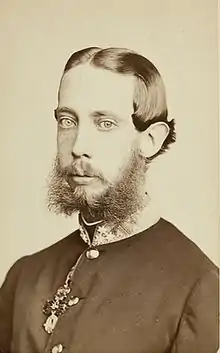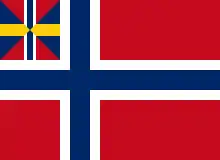Archduke Ludwig Viktor of Austria
Archduke Ludwig Viktor Joseph Anton of Austria (15 May 1842 – 18 January 1919) was a younger brother of Emperor Franz Joseph I. He had a military career, as was usual for archdukes, but did not take part in politics. He was openly homosexual and declined to marry princesses who were sought for him. He is well known for his art collection and patronage as well as philantropy.
| Archduke Ludwig Viktor | |||||
|---|---|---|---|---|---|
 | |||||
| Born | 15 May 1842 Hofburg Palace, Vienna, Austria | ||||
| Died | 18 January 1919 (aged 76) Schloss Klessheim, Austria | ||||
| Burial | Siezenheim Cemetery | ||||
| |||||
| House | Habsburg-Lorraine | ||||
| Father | Archduke Franz Karl of Austria | ||||
| Mother | Princess Sophie of Bavaria | ||||
Family

Ludwig Viktor was born in Vienna. He was the youngest son born to Archduke Franz Karl of Austria and Princess Sophie of Bavaria. His elder siblings included Emperor Franz Joseph I of Austria, Emperor Maximilian I of Mexico and Archduke Karl Ludwig.
Career
During the Revolutions of 1848 and the Vienna Uprising, Ludwig Viktor and his family had to flee the Austrian capital, at first to Innsbruck, later to Olomouc. Ludwig Viktor pursued the usual military career and was appointed General of the Infantry, but had no intentions to interfere in politics. He rejected his brother Maximilian's ambitions in the Second Mexican Empire. Instead he concentrated on building up his own art collection and had Heinrich von Ferstel design and build a city palace on the new Schwarzenbergplatz in Vienna, where Ludwig Viktor hosted homophile soirées.
Personal life
Ludwig Viktor's mother attempted to arrange a marriage for him with Duchess Sophie Charlotte in Bavaria, youngest sister of Empress Elisabeth, but he declined. He likewise rejected plans to marry him to Isabel, daughter and heir presumptive of Emperor Pedro II of Brazil. He was openly homosexual and known for transvestitism. After a scandalous incident at the Central Bathhouse Vienna in which he was publicly slapped,[1] his brother Emperor Franz Joseph finally forbade him to stay in Vienna and joked that he should be given a ballerina as adjutant to keep him out of trouble.
Ludwig Viktor retired to Klessheim Palace near Salzburg where he became known as a philanthropist and patron of the arts. He died in 1919, at the age of 76, and is buried at the Siezenheim cemetery.
He was awarded Order of the White Eagle.[2]
Honours
He received the following orders and decorations:[3]
 Austrian Empire:[4]
Austrian Empire:[4]
- Knight of the Golden Fleece, 1862
- Grand Cross of St. Stephen, 1893
.svg.png.webp) Sovereign Military Order of Malta: Bailiff Grand Cross of Honour and Devotion, with Distinction for Jerusalem
Sovereign Military Order of Malta: Bailiff Grand Cross of Honour and Devotion, with Distinction for Jerusalem Russian Empire:
Russian Empire:
- Knight of St. Andrew
- Knight of St. Alexander Nevsky
- Knight of the White Eagle
- Knight of St. Anna, 1st Class
 United Kingdom: Honorary Grand Cross of the Royal Victorian Order, 9 October 1903[5]
United Kingdom: Honorary Grand Cross of the Royal Victorian Order, 9 October 1903[5].svg.png.webp) Kingdom of Prussia:
Kingdom of Prussia:
- Knight of the Black Eagle
- Knight of the Red Eagle, 1st Class
.svg.png.webp) France: Grand Cross of the Legion of Honour
France: Grand Cross of the Legion of Honour_crowned.svg.png.webp) Kingdom of Italy: Knight of the Annunciation, 21 September 1873[6]
Kingdom of Italy: Knight of the Annunciation, 21 September 1873[6]
.svg.png.webp) Kingdom of Bavaria: Knight of St. Hubert, 1867[7]
Kingdom of Bavaria: Knight of St. Hubert, 1867[7].svg.png.webp) Kingdom of Saxony: Knight of the Rue Crown, 1865[8]
Kingdom of Saxony: Knight of the Rue Crown, 1865[8].svg.png.webp) Spain: Grand Cross of the Order of Charles III, 28 September 1891[9]
Spain: Grand Cross of the Order of Charles III, 28 September 1891[9] Württemberg: Grand Cross of the Württemberg Crown, 1867[10]
Württemberg: Grand Cross of the Württemberg Crown, 1867[10].svg.png.webp)
 Sweden-Norway: Knight of the Seraphim, 19 April 1885[11]
Sweden-Norway: Knight of the Seraphim, 19 April 1885[11].svg.png.webp) Belgium: Grand Cordon of the Order of Leopold
Belgium: Grand Cordon of the Order of Leopold.svg.png.webp) Kingdom of Greece: Grand Cross of the Redeemer
Kingdom of Greece: Grand Cross of the Redeemer Kingdom of Romania: Grand Cross of the Star of Romania
Kingdom of Romania: Grand Cross of the Star of Romania.svg.png.webp) Principality of Serbia:
Principality of Serbia:
.svg.png.webp) Siam: Knight of the Order of the Royal House of Chakri, 23 June 1897[12]
Siam: Knight of the Order of the Royal House of Chakri, 23 June 1897[12] Grand Duchy of Hesse: Grand Cross of the Ludwig Order, 26 July 1858[13]
Grand Duchy of Hesse: Grand Cross of the Ludwig Order, 26 July 1858[13].svg.png.webp) Saxe-Weimar-Eisenach: Grand Cross of the White Falcon, 2 September 1864[14]
Saxe-Weimar-Eisenach: Grand Cross of the White Falcon, 2 September 1864[14] Mecklenburg: Grand Cross of the Wendish Crown, with Crown in Ore
Mecklenburg: Grand Cross of the Wendish Crown, with Crown in Ore.svg.png.webp) Nassau Ducal Family: Knight of the Gold Lion of Nassau
Nassau Ducal Family: Knight of the Gold Lion of Nassau Brunswick: Grand Cross of Henry the Lion, 1876[15]
Brunswick: Grand Cross of Henry the Lion, 1876[15].svg.png.webp)
.svg.png.webp)
.svg.png.webp) Ernestine duchies: Grand Cross of the Saxe-Ernestine House Order
Ernestine duchies: Grand Cross of the Saxe-Ernestine House Order
Ancestry
| Ancestors of Archduke Ludwig Viktor of Austria |
|---|
References
- Kastl, Robert. "Gay and Lesbian Life in Vienna". Archived from the original on 27 September 2007. Retrieved 25 June 2007.
- Acović, Dragomir (2012). Slava i čast: Odlikovanja među Srbima, Srbi među odlikovanjima. Belgrade: Službeni Glasnik. p. 581.
- "Genealogie des Allerhöchsten Herrscherhauses", Hof- und Staatshandbuch der Österreichisch-Ungarischen Monarchie, 1918, p. 3, retrieved 28 August 2020
- "Ritter-Orden", Hof- und Staatshandbuch der Österreichisch-Ungarischen Monarchie, 1912, pp. 50, 53, retrieved 28 August 2020
- The London Gazette, issue 27604, p. 6147
- Italia : Ministero dell'interno (1898). Calendario generale del Regno d'Italia. Unione tipografico-editrice. p. 53.
- Hof- und Staats-Handbuch des Königreich Bayern (1908), "Königliche Orden" p. 8
- Staatshandbuch für den Freistaat Sachsen: 1865/66. Heinrich. 1866. p. 4.
- "Real y distinguida orden de Carlos III", Guía Oficial de España, 1911, p. 168, retrieved 23 July 2020
- Hof- und Staats-Handbuch des Königreich Württemberg (1907), "Königliche Orden" p. 27
- Sveriges Statskalender (in Swedish), 1905, p. 440, retrieved 6 January 2018 – via runeberg.org
- Royal Thai Government Gazette (8 January 1898). "พระราชทานเครื่องราชอิสริยาภรณ์ ที่ประเทศยุโรป" (PDF) (in Thai). Retrieved 8 May 2019. Cite journal requires
|journal=(help) - Hof- und Staats-Handbuch des Großherzogtum Hessen (1879), "Großherzogliche Orden und Ehrenzeichen" p. 11
- Staatshandbuch für das Großherzogtum Sachsen / Sachsen-Weimar-Eisenach (1869), "Großherzogliche Hausorden" p. 12
- Hof- und Staatshandbuch des Herzogtums Braunschweig für das Jahr 1897, "Herzogliche Orden Heinrich des Löwen" p. 10
- Wurzbach, Constantin, von, ed. (1860). . Biographisches Lexikon des Kaiserthums Oesterreich [Biographical Encyclopedia of the Austrian Empire] (in German). 6. p. 208 – via Wikisource.
- Wurzbach, Constantin, von, ed. (1860). . Biographisches Lexikon des Kaiserthums Oesterreich [Biographical Encyclopedia of the Austrian Empire] (in German). 6. p. 257 – via Wikisource.
- Wurzbach, Constantin, von, ed. (1861). . Biographisches Lexikon des Kaiserthums Oesterreich [Biographical Encyclopedia of the Austrian Empire] (in German). 7. p. 81 – via Wikisource.
- Genealogie ascendante jusqu'au quatrieme degre inclusivement de tous les Rois et Princes de maisons souveraines de l'Europe actuellement vivans [Genealogy up to the fourth degree inclusive of all the Kings and Princes of sovereign houses of Europe currently living] (in French). Bourdeaux: Frederic Guillaume Birnstiel. 1768. p. 94.
- Wurzbach, Constantin, von, ed. (1861). . Biographisches Lexikon des Kaiserthums Oesterreich [Biographical Encyclopedia of the Austrian Empire] (in German). 7. p. 149 – via Wikisource.
- "Karoline Friederike Wilhelmine Königin von Bayern". Haus der Bayerischen Geschichte [House of Bavarian History] (in German). Bavarian Ministry of State for Wissenschaft and Kunst. Retrieved 30 November 2018.
- Helmut Neuhold: Das andere Habsburg. Homoerotik im österreichischen Kaiserhaus, Tectum-Verlag
External links
![]() Media related to Archduke Ludwig Viktor of Austria at Wikimedia Commons
Media related to Archduke Ludwig Viktor of Austria at Wikimedia Commons